Ryan Hall's Blog, page 121
October 9, 2017
Inside The Shockingly Competitive World Of Joggling
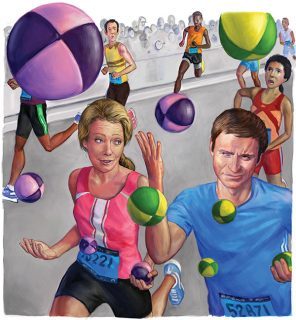
Illustration: Matt Collins
It’s a typical scene on the outdoor track at Coe College in Des Moines, Iowa: eight lanes, each occupied by a racer ready to go. An official aims a starting pistol in the air. The runners take their marks, get set and … juggle?
This is the 100-meter dash at the 70th Annual International Jugglers’ Association track meet. This particular race, which took place at 11 a.m., is not the same 100-meter dash that happened two hours earlier. That was the three-ball division. This is the seven-ball division. The big leagues. The grand enchilada of joggling.
For those unfamiliar with joggling, it’s a competitive sport that requires athletes to simultaneously juggle and jog. It sounds like a circus event, but it’s not all Cracker Jacks and candied cotton. Joggling is a real thing—and it’s cutthroat.
RELATED: Runner Suits Up And Sets A New Guinness World Record
“Joggling is shockingly competitive,” says Michal Kapral, a joggler who holds several world records. “There are probably only about 1,000 or so people in the world who joggle, but competition for the world records is fierce.”
Case in point: In 2005, Kapral set a world record in marathon joggling with three balls—his time was 3:07:41. Only a few months later, Zach Warren of West Virginia broke his record by just 39 seconds. The gauntlet was thrown down, and they’ve since spent several years trading the record back and forth several times and squaring off at a couple of epic marathon joggling duels at the Boston and Salt Lake City marathons.
Yes, you read that correctly: “epic marathon joggling duels.” So epic, their rivalry was featured in a 2011 documentary “Breaking and Entering.” Kapral holds the current three-object record of 2:50:12.
There are joggling competitions for just about every running event: track sprints, hurdles, road races, ultrarunning—there’s even a joggling beer mile, casually referred to in joggling circles as “choggling.”
Kapral assures me joggling is much simpler than it looks: “The three-ball juggling pattern syncs up perfectly with the arm swing of running. It’s just one ball toss every time you swing your arm forward.”
I gave it a try. On the first attempt, I missed my catch. The second time, I took a beanbag to the face. It was awkward and clumsy—and Kapral does this for 26.2 miles? I couldn’t even make it one step.
RELATED: Weirdest Guinness World Record 100m Races
“The really tough part is joggling near the end of a marathon. When your body starts to shut down and your brain turns to mush, you still have to find a way to keep tossing and catching those beanbags. It’s absolute agony, which is kind of funny because spectators are smiling and laughing at the sight of a guy juggling as he runs, while I’m suffering like no tomorrow.”
And yet, Kapral loves the suffering. This month, he’ll go for a new Guinness World Record: joggling with fi ve balls at the Toronto Waterfront Marathon.
“It’s going to be a doozy!” Kapral says with a laugh. “There is no current record, because no one has been stupid enough to try and set it.”
The post Inside The Shockingly Competitive World Of Joggling appeared first on Competitor.com.
Cancer Patient Runs Ultras To Raise Funds For Cancer Research
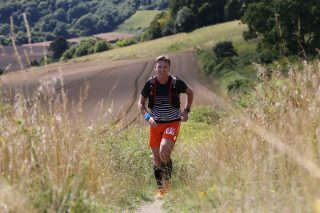
It was May when Mark Thornberry got the news: primary liver cancer. In June, the other shoe dropped. The cancer had spread into his vascular system and was circulating throughout his body. His prognosis morphed from potentially treatable to terminal. As the 57-year-old runner absorbed the news, he made a decision: “I could sit around and moan about it, or I could do something positive,” he says.
He chose the latter.
Thornberry, from Surrey, England, has always been a runner, something he originally began as an adjunct to rugby. As often happens with running, Thornberry found himself swept along with the sport and about five years ago, he started venturing into ultras. He has since covered many 50Ks, 50-milers and even a few 100-milers.
One bucket list item for Thornberry was the Grand Union Canal Race, Britain’s oldest ultra. Stretching from Birmingham to London along the canal, the race totals 145 miles. Competitors have 45 hours to complete the distance and organizers grant entry to only 100 competitors each year.
Thornberry was among the lucky few to snag a spot in the 2017 event on May 27, but the timing of his diagnosis meant he had to pull out. “I was going through treatment, and three days before the race, I knew I couldn’t complete it,” he says. “It’s such an iconic event and I was amazed to get a slot, so this was incredibly disappointing for me.”
The inability to complete the race wore on Thornberry and eventually, he thought of a way to use his frustration for the greater good—and run the race course anyway.
Thornberry’s plan: To raise funds via his canal run for liver cancer research at King’s College Hospital, where he receives treatment. “Liver cancer is underfunded when you compare it to some other cancers, like breast and lung,” he explains. “I decided that with whatever time I have left, I could do something positive.”
In early September, feeling good enough to take on the 145 miles along the canal, Thornberry set out with the goal of running the course over three days. “Coming off lowered fitness and radiation treatments, I wasn’t sure how it would go,” he says. “But I wanted to try.”
Thornberry sought out the blessing of his physicians, who told him to go for it, provided he was careful and stayed on top of his hydration. He went into the adventure with an open mind, knowing he might have to bail if he felt too bad at some point.
RELATED: Doctors Said I’d Never Run Again But I Proved Them Wrong
Using social media, Thornberry spread the word about his fundraising plans and asked other runners to join him along the Grand Canal route. He never imagined it would grow into the event that it did.
“Every day, I had different people running with me,” he says. “I had four friends who stuck with me for all three days, and 60 others who jumped in at one point or another.”
Thornberry says that he felt surprisingly good throughout the entire 145 miles. “I wasn’t sure I could do it, but when you get so many people joining your efforts, it goes a long way,” he says. “I had nurses checking in on me at different points, and everyone was on top of my needs.”
Whether it was joining him for several miles or providing food and hydration, Thornberry was overwhelmed by the support. “I felt love and concern from so many—the ultra community wasn’t going to let me go it alone,” he says. “I was terribly humbled.”
By the end of the three days, Thornberry had raised £52,000 (roughly $68,000). “All I want to do is pay it forward,” he says. “I want others to know that a diagnosis like this doesn’t have to be all dark.”
A month and a half later, Thornberry is feeling fairly good as the targeted radiation he receives seems to be keeping his tumor site and surrounding blood vessel spread in check. He’s pleased with the amount of running he can manage at the moment as well. “I’m not too far off running as I normally would do,” he says. “I am currently on day 21 of a run streak, running between five and eight miles every day.”
Running, in fact, has helped Thornberry stay as healthy as he has throughout this journey.
“The fact that I’m in good shape helps me tolerate these intensive treatments,” he says. “The medics are happy for me to keep doing long mileage as long as it presents no physical discomfort. They admit I am a somewhat left-field patient as a 57-year-old who runs 100-milers for fun.”
Indeed, Thornberry is feeling so good that he has registered for the Javelina Jundred 100-mile race in Arizona at the end of this month. “This is to keep the momentum going on my fundraising efforts,” he says. “Plus, it’s a Western States qualifier—with a 30-hour time limit, finishing in 29:59 would be just fine.”
Thornberry has found that his greater purpose has done wonders for his attitude and ability to stay positive in the midst of an otherwise grim situation. “Having running goals and tying them to my fundraising has helped me keep away from those dark places,” he says.
To date, Thornberry has raised over £70,000 (about $92,000) for the research hospital, a sum sure to have a lasting impact.
“I’m hoping the reason people have donated is that they have some sort of positive connection with me and what I am trying to do,” he says. “The sum raised is a physical manifestation of that. This experience has served as a reaffirmation to me that there are some great people out there.”
RELATED: Running Community Rallies To Support Gabe Grunewald’s Cancer Treatment
The post Cancer Patient Runs Ultras To Raise Funds For Cancer Research appeared first on Competitor.com.
2018 Chicago Marathon Application Period Opens In October
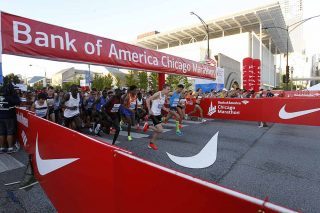
Photo: Courtesy of Chicago Marathon
On the heels of this years’ Chicago Marathon comes the announcement that the application process for the 2018 edition is just around the corner. Beginning Oct. 24, runners can begin submitting applications for the 41st edition of the race.
RELATED: Rupp and Dibaba Dominate At 2017 Chicago Marathon
What Type Of Applicant Are You?
There are both guaranteed and non-guaranteed application processes; with qualifications as follows (as outlined by race officials in a release):
Guaranteed entry opportunities:
Time qualifiers who have met the event’s age graded qualifying standards or qualify for the event’s American Development Program.
Legacy finishers who have completed the Chicago Marathon five or more times within the last 10 years.
Runners who cancelled their 2017 entry through the event deferment opportunity.
Charity runners who are fundraising for an official charity as part of the Chicago Marathon Charity Program.
International runners (non-U.S.) participating in the official International Tour Group Program.
Runners who have completed the Bank of America Shamrock Shuffle 8K four or more times since 2008 and have signed up for the 2018 Shamrock Shuffle.
Non-guaranteed entry:
Runners who do not qualify for a guaranteed entry can apply for the non-guaranteed entry drawing. The event will select names from the full pool of non-guaranteed entry applicants and notify runners of their selection status on Tuesday, Dec. 12, 2017.
“The Bank of America Chicago Marathon continues to be one of most prestigious marathons in the world. We are proud of our history as a race that welcomes runners—from the debut runner to the charity runner to the world class elite—to our beautiful city,” said Chicago Marathon Executive Race Director Carey Pinkowski in a release. “After celebrating 40 years with more than 43,000 runners crossing the finish line in Grant Park, we are excited to ring in 41 years in 2018.”
RELATED: 5 Pieces of Special Edition Chicago Marathon Gear
Important Dates To Remember
If you meet the qualifications for guaranteed entry, you can apply between Oct. 24 and Nov. 30. All runners who are seeking non-guaranteed entry can begin the application process on Tuesday, Oct. 31 and also have through Nov. 30 to submit an application. The cost of an entry is $195 for United States residents and $220 for those residing outside of the United States.
The post 2018 Chicago Marathon Application Period Opens In October appeared first on Competitor.com.
5 Healthy Ways Runners Can Indulge Sugar Cravings
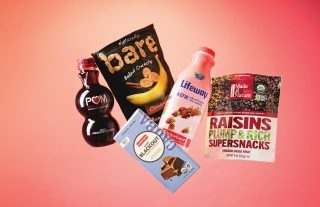
Photo: Oliver Baker
In recent years, sugar has become somewhat of a nutritional bogeyman. That’s because high intakes of sugar, or more accurately sugars added to foods, have been linked to a laundry list of ailments ranging from heart disease to diabetes to cancer—not to mention expanding waistlines. All of which may have you believing that there is no safe way to tame a sweet tooth. The good news is that you don’t need to take sugary foods off of your kitchen playlist. The key is being choosy about where you get your fix. We rounded up five sweet treats that runners can feel good about.
Raisins
Turns out the parched grapes can help you raise your speed. Researchers in the Journal of the International Society of Sports Nutrition found that raisins were just as effective as more expensive carbohydrate-based sport chews at keeping runners’ endurance levels up during an 80-minute run followed by a 5K time trial. Raisins contain a cocktail of fast-working sugars that supply a useful energy source for muscles in motion.
Action Plan: During long workouts, try eating ¼–¹⁄³ cup raisins, along with water, for every hour of exercise.
Best Buy: Made in Nature Organic Raisins, $5 for 9 ounces
RELATED: Does Sugar Deserve Such A Bad Reputation?
Chocolate
It’s a good idea to embrace your inner Wonka. British scientists discovered that athletes who snacked on 40 grams of dark chocolate daily experienced a decrease in the oxygen cost of exercise and increase in endurance capacity compared to when they nibbled on white chocolate. Other research suggests the dark delight can lessen exercise-induced muscle stress. These benefits likely stem from lofty amounts of flavanol antioxidants.
Action Plan: For a greater dose of antioxidants, look for at least 70 percent cocoa and snack on 1 ounce daily.
Best Buy: Alter Eco Dark Blackout, $4
Pomegranate Juice
Forget soda or OJ. Modern research suggests that pomegranate juice can lessen signs of muscle damage associated with vigorous exercise—an important perk considering it can quicken recovery time. The polyphenol-rich juice appears to increase the antioxidant defense system in the body. More good news: It’s also a source of the electrolyte potassium to aid with proper muscle functioning.
Action Plan: Look for bottles not cut with filler juices like apple or pear. Drink 1–2 cups a day during heavy training.
Best Buy: Pom Wonderful 100% Pomegranate Juice, $4 for 16 ounces
Bananas
Cyclists with a banana sticking out of their jersey pockets are on to something. A study in the journal Plos One reported that during a 75K bike ride, bananas —when consumed with water—were just as effective as a sports drink at bolstering endurance. The monkey food contains a winning mix of carbs and electrolytes, like potassium, that can benefit runners as well.
Action Plan: Add ripe bananas (black spots on the skin mean more easy-to-digest sugars) to smoothies and oatmeal. For run convenience, bring a stash of baked banana chips.
Best Buy: Bare Cinnamon Banana Chips, $4 for a 2.7-ounce bag
RELATED: The Straight Dope On Sugar In Sports Drinks
Kefir
If you like sweetened dairy, consider kefir. This cultured, yogurt-like product is home to a sizable population of friendly critters known as probiotics, which may help lessen post-exercise inflammation as well as fortify your immune system, so you’re less likely to come down with the sniffles. Fruit-flavored kefir supplies a duo of sugars (both natural and added) with protein that can kick-start muscle recovery much like chocolate milk would.
Action Plan: After a sweat session, gulp 1 cup. Also use in smoothies, granola and pancake batter.
Best Buy: Lifeway Strawberry Low Fat Kefir, $6 for 32 ounces
The post 5 Healthy Ways Runners Can Indulge Sugar Cravings appeared first on Competitor.com.
Rupp and Dibaba Dominate At 2017 Chicago Marathon
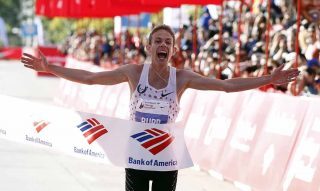

Galen Rupp finishes first in 2:09:20. Photo: Courtesy of Chicago Marathon
With powerful second half performances, Galen Rupp and Tirunesh Dibaba won the Chicago Marathon, overwhelming strong fields on a warm and sunny day that saw some of the world’s best runners drop out. They recorded times of 2:09:20 and 2:18:31, respectively, in what was the 40th edition of America’s second-largest marathon. Also, Rupp became the first American man to win Chicago since Khalid Khannouchi in 2002.
Close behind Dibaba in third place, American Jordan Hasay ran a sensational 2:20:57 in just her second marathon, making her the second-fastest American woman of all time behind only Deena Kastor. She topped Joan Samuelson’s American course record of 2:21:21 set back in 1985.
Men’s Race Recap
In the third consecutive edition of this race with no pacemakers, none of the top men were keen to push the pace in the early kilometers. American Aaron Braun, who wanted to run in the 2:11 to 2:12 range, led a 27-man lead pack through 5K in a tepid 15:43, a 2:12:37 pace. That pack stayed largely intact through halfway and things barely picked up with a half-marathon split of 1:05:49. That was fine with Rupp.
“Coming in, taking to my coaches, my plan was to be invisible for the first 20, 22 miles,” Rupp told reporters after the race. “Here I think it was really important for me to sit back, relax and conserve energy.”
Although the temperature was a comfortable 60 degrees at the start, the sun was out and Chicago’s open course offered very little shade. The top athletes started to glisten with sweat, and some of the top names in the field were having trouble keeping up and had to drop out. Stanley Biwott, the 2015 New York City Marathon champion, stuck with the leaders at 25K, but couldn’t make it to the 30K checkpoint. World record holder Dennis Kimetto was leading at halfway, but was soon seen by race spotters limping on the side of the course and never made it to 25K.
Rupp, however, was feeling comfortable and was content to wait.
“You know, I hadn’t really planned out when I was going to go,” he said in his post-race television interview. “I definitely wanted to wait, at least 20 miles, 22 miles. The longer the better. I’ve made the mistake in the past of going too hard, too soon; you’ve still got a long way to go, several miles. So, I really wanted to wait.”
At the 30K checkpoint, 10 men were still in contention: Rupp, defending champion Abel Kirui, Bernard Kipyego, half-marathon world record holder Zersenay Tadese, Ezekiel Chebii, Chris Derrick, Olympic silver medalist Feyisa Lilesa, Sisay Lemma, Sam Chelanga and Stephen Sambu. Rupp decided to wait for the 35th kilometer before upping the tempo, and the race got serious in a hurry. By 35K checkpoint only Rupp, Kirui, Lemma, Kipyego and Sambu were left. Rupp decided it was time to go for the kill.
“At that point, you have to be all in,” Rupp explained. “You can’t think you’re going to go and back off. You have to drive all the way to the finish line.”
Rupp ran the 5K through 40K in 14:25, easily the fastest 5K segment of the race, putting the race out of reach. For good measure, he ran the 41st kilometer in 2:38, the fastest kilometer of the race. He then ran his second half in 1:03:30.
“It’s just incredible,” Rupp said about breaking the finish line tape in the city where his father grew up. “You know, you train so hard year-in and year-out, day-in and day out. To have a race like this where it all comes together and be able to win in a city which is such a special place for me given that my dad grew up here. Words can’t describe the feeling of crossing the line, seeing my family, my coach.”
Kirui was a clear second in 2:09:48, and Kipyego passed Lemma to take third, 2:10:23 to 2:11:01. Sambu, who made his debut here last year, finished fifth in 2:11:07. Back in ninth place, American Chris Derrick made a successful marathon debut in 2:12:50, and Lilesa finished 14th in 2:14:49.
Women’s Race Recap

Tirunesh Dibaba won the women’s race in 2:18:31. Photo: Courtesy of Chicago Marathon
Dibaba, who ran a personal best at the London Marathon last April in 2:17:56—the fifth-fastest performance of all time—was the leader of the women’s race from the gun. She was intent on running fast first, then would worry about sorting out the top places later.
“I actually wasn’t running against anyone, but was just running to improve my personal best,” Dibaba told reporters later with the help of an interpreter.
Dibaba ran the first four 5K segments in 16:08, 16:20, 16:34, and 16:33, and hit halfway in 1:08:48. Four other women managed to hold that pace: defending champion Florence Kiplagat, Brigid Kosgei, Valentine Kipketer, and Jordan Hasay. The group was running at a 2:18:22 pace, and Hasay decided that she should try to hang on, despite running well under American record pace.
“One of the reasons I went with the lead pack today is that I wanted to be up there,” Hasay explained. “I could have run my own pace today, (but) I think it’s important to show we can compete with them. Obviously, it can be really intimidating.”
Dibaba’s next three 5K segments just couldn’t be matched by her competitors: 16:24, 16:29, and 16:22. Kiplagat never made it to 30K and dropped out. Kosgei managed to stay close through 30K, but then had to let go and would finish second in a personal best of 2:20:22. Kipketer struggled, slowed badly, and ended up fifth in 2:28:05.

American Jordan Hasay came in third and ran an American course record of 2:20:57. Photo: Courtesy of Chicago Marathon
Hasay, in perhaps her most determined effort of her career, hung on and talked her way through the final kilometers. She said she thought of her late mother and the hard workouts she had done under coach Alberto Salazar. Positive self-talk was the key, she said.
“The whole last part was really tough,” Hasay admitted. She continued: “I just tried to go mile by mile.”
Hasay’s 2:20:57 was extraordinary. She had only run her marathon debut this past April in Boston in an impressive 2:23:00, and to drop that time by over two minutes was surprising, especially for the 26-year-old athlete originally from Arroyo Grande, Calif.
“I’m really grateful,” Hasay said. “I always hoped I’d be great at the marathon.” She continued: “For this to go so well, this is in some ways a relief.”
(c) 2017 Race Results Weekly, all rights reserved
The post Rupp and Dibaba Dominate At 2017 Chicago Marathon appeared first on Competitor.com.
October 8, 2017
Photos: Highlights From The 2017 Chicago Marathon Expo
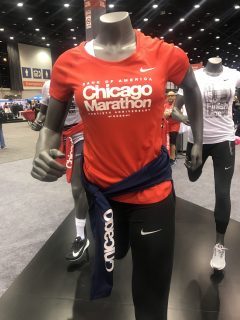
The Chicago Marathon race weekend kicked off with the Abbott Health & Fitness Expo on Friday. After runners pick up their race bib, they can have their pick of Windy City themed apparel, shoes and gifts to commemorate their 26.2 around Chicago. Here are some photos from the expo of Chicago gear. And don’t forget to watch the Chicago Marathon on Sunday, October 8th. Not sure how to tune in? We have all the details here.
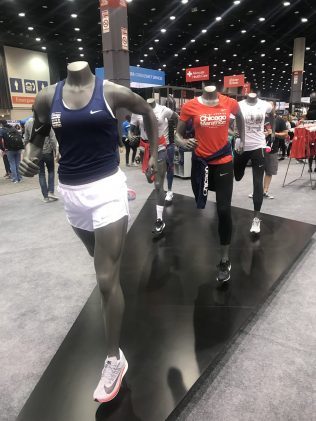
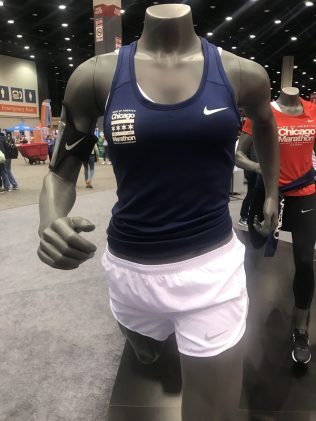
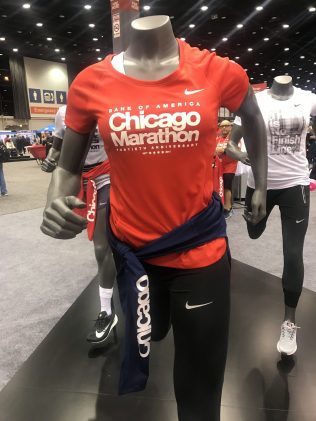
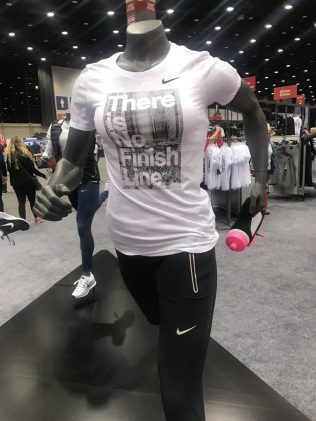
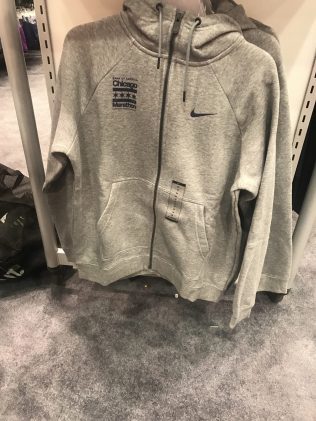
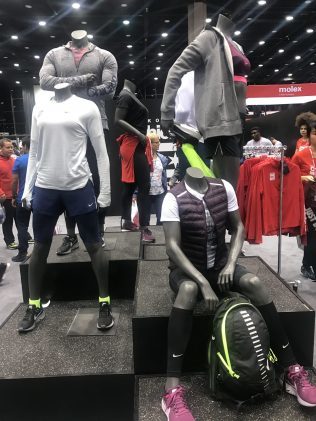






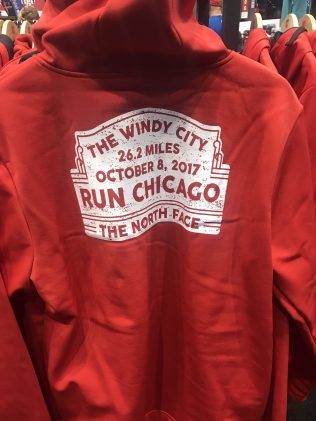
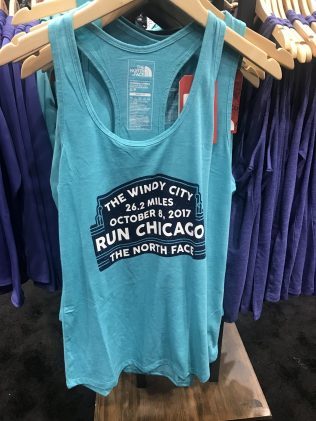
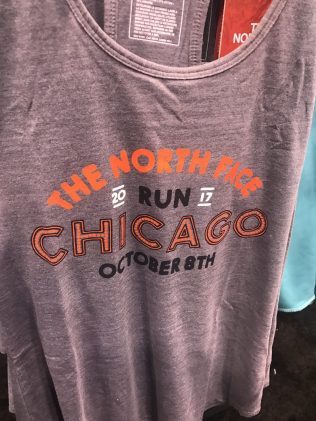
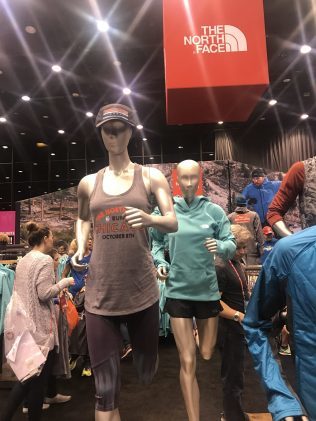

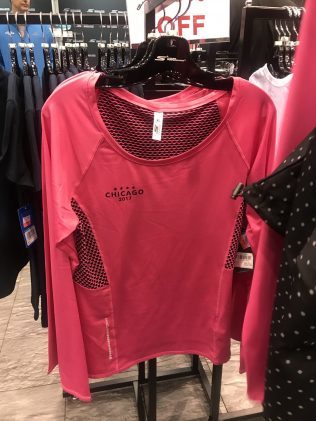
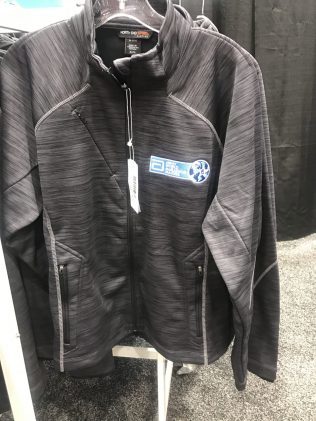
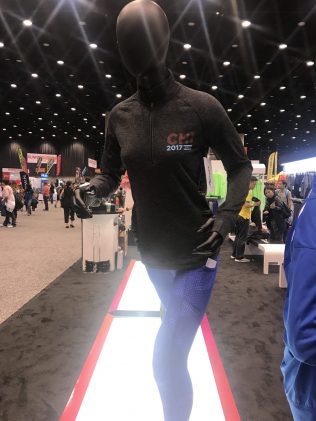


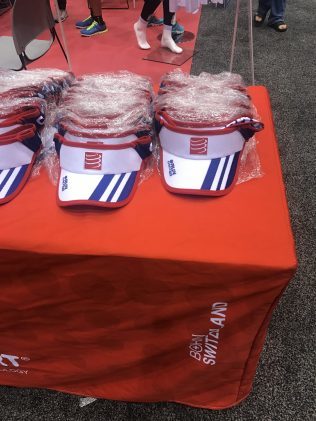

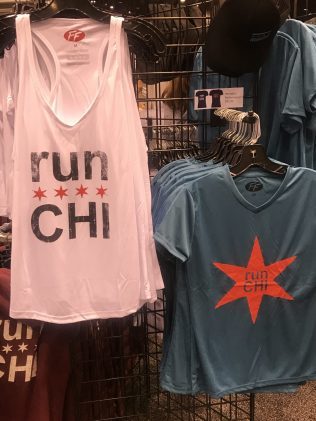
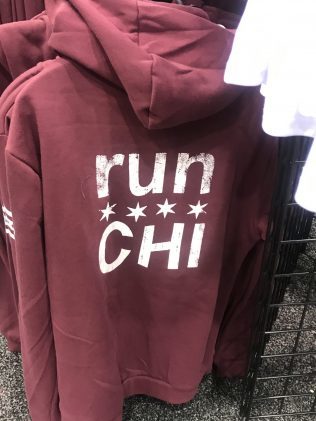
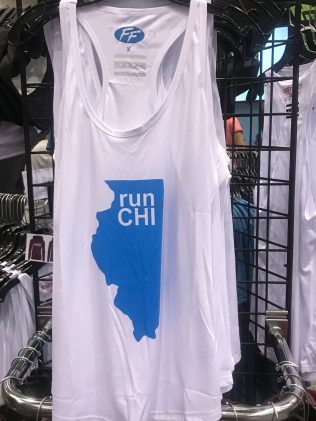
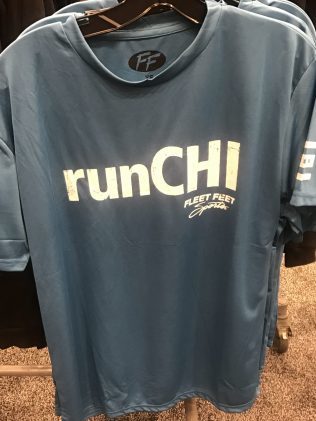


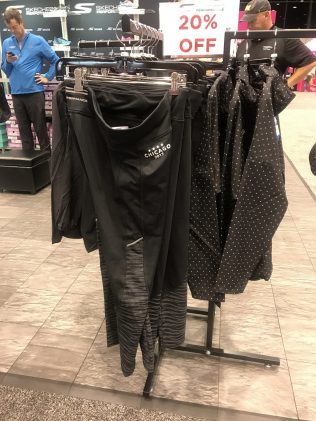

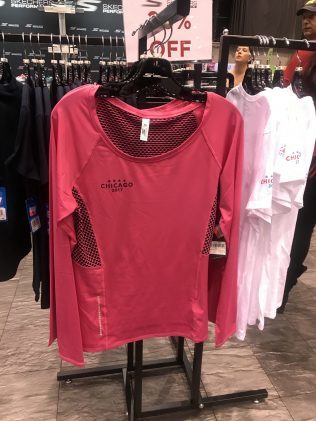
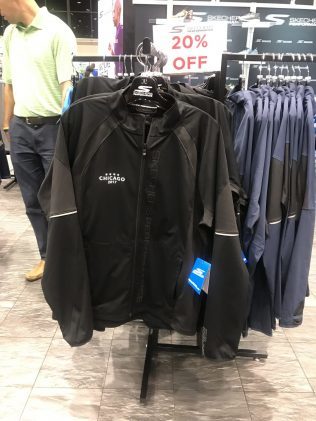
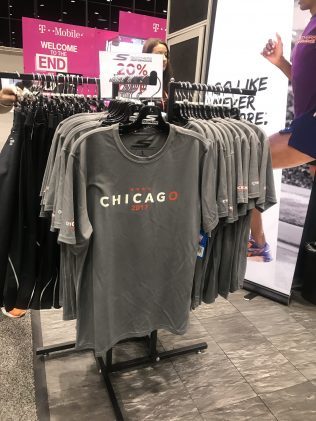
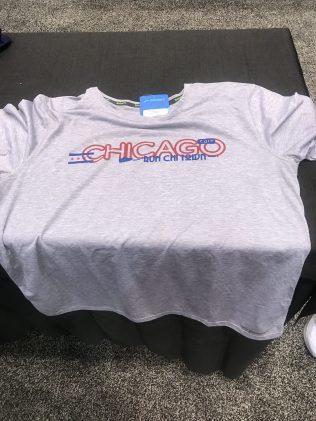

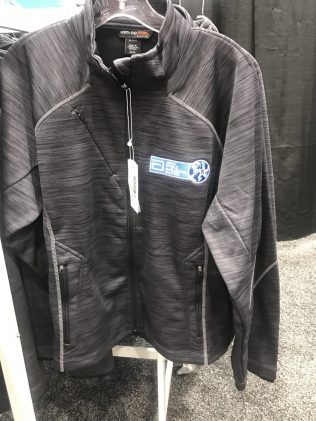
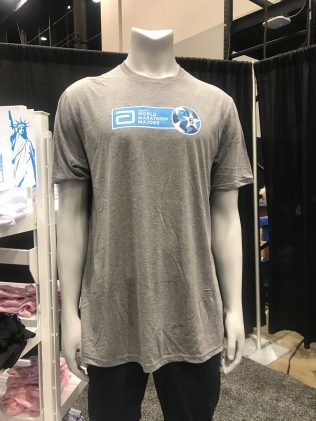
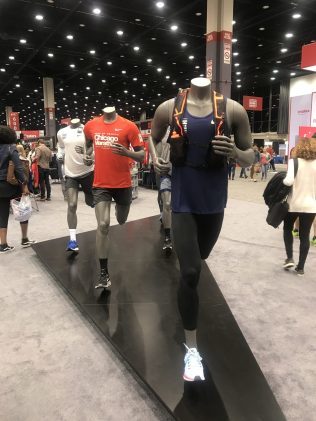
The post Photos: Highlights From The 2017 Chicago Marathon Expo appeared first on Competitor.com.
October 6, 2017
Follow These Three Steps To Perfect Your Running Form

Photo: Shutterstock
The great thing about running is that just about anyone can do it. No special equipment or specialized training is needed. You just go out your front door and run. While there aren’t any special pieces of equipment or previous training you’ll need, there are a few things you can do to build your proper foundation. Once you perfect your form, runs are much more enjoyable, efficient and goal-oriented.
Posture
Proper running posture does not come naturally to many people. It is something you may have to focus on in the beginning. My running coach has pounded into my head, “Hips forward, shoulders back. Arms are loose, now run relaxed.” These tips allow for proper breathing, the most efficient use of your muscles, and the reduction of possible pain and injury.
Feet
Pick up your feet when you run. This skill is uncomfortable at first. But if you build the muscles required to do this, it will help you on longer runs when you start to get tired. If you drag your feet, you will slow down. This increases the chance of injury. Take a break by slowing down or walking, but then make a mental note to work on lifting those legs!
Breathing
How do you know if you’re running too fast? Check your breathing! You should be able to speak in short sentences when running at the proper pace. Yes, in speed training this doesn’t exactly apply. But when on your long distance runs, focus on breathing calmly, deeply and slowly.
If you can focus on these three things when you start running, they will eventually become second nature. This skill will supply a great foundation as a strong and efficient runner. And the best part is proper form, combined with smart training, will eventually make you faster.
Related: Here’s Exactly How To Crush Your Next Half Marathon
The post Follow These Three Steps To Perfect Your Running Form appeared first on Competitor.com.
Why Runners Should Get A Flu Shot

While the start of October ushers in crisp weather and fall marathons, it is also marks the beginning of another time: flu season. In the United States, flu outbreaks typically begin at the beginning of October and can occur as late as May. The Centers for Disease Control estimates that flu-related hospitalizations since 2010 ranged from 140,000 to 710,000, while flu-related deaths are estimated to have ranged from 12,000 to 56,000.
Most runners think of themselves as healthy individuals who are not prone to sickness. But even the healthiest endurance athletes can catch Influenza A. For active runners, the flu can be very unpleasant. But for others around us, catching it could be a life or death experience.
RELATED: Should You Train When You’re Sick?
Getting a seasonal flu shot is the best way to protect yourself and those around you from getting Influenza A. However many runners bristle at the thought of the vaccine. Here is why it is beneficial for healthy, active people.
Why You Should Get A Flu Shot
Flu season falls within both the fall and spring marathon training cycles. Coming down with the illness could seriously impact your race preparation and recovery.
“Influenza A can knock even a healthy person on their back for five days so if you get this illness, you’re potentially missing up to a week or more of training,” says Dr. David Schechter, MD, a family and sports medicine physician based in Culver City California and author of the book Think Away Your Pain.
After a successful race, runners are at a greater risk for catching an illness. Immune systems can be impaired for a week or more after competiton.
“There have been many studies that have shown an increased risk of colds during that week,” says Dr.Schechter. “Therefore it’s logical to assume that if you’re exposed to someone with the flu, then you’ll have a higher incidence of getting the flu the week after a marathon.”
Getting vaccinated is also not just about individual health. If more people get a flu shot, it is less likely that Influenza A will spread through a community, becoming an epidemic. This is especially important for runners who are around children, elderly or any other population where catching a flu could be life threatening. Plus the last thing you want to do is spread an illness around to everyone in your running group.
Of course there are people who simply cannot get the flu shot. Those who have had an allergic reaction to a past flu shot or have an egg allergy are typically advised not to get one. Consult a doctor if you have any worries.
Flu Shot Myths
Besides a fear of shots or needles, some runners worry that the vaccine itself could cause the flu. This is a mistaken notion though. Runners do not need to reduce their training as a result of getting the shot. It does not cause any illness and won’t impact any athletic pursuits.
Side effects can include soreness at the point of injection and fatigue that lasts for 12 hours. However many people don’t feel any different. While it won’t affect training, it still probably is a good idea to get the flu shot at least a week before or right after a goal race.
A common misleading claim is that flu shots don’t work. People will state that they got sick the year they received a flu shot, but remained healthy when they did not.
“What I’ll say to them is you may have gotten sick 2 years ago but did you really have Influenza A or did you have another kind of illness,” said Dr. Schechter.
RELATED: Sick? Go Run With A Sports Drink.
Influenza A comes on suddenly, with fever, aches, chills, fatigue headache and cough. In severe cases, vomiting and diarrhea can occur. These symptoms are much more pronounced than with a seasonal cold. It’s true that a flu shot won’t protect against a cold. But Influenza A is much worse and takes longer to recover from.
“If you’re talking about younger athletic people, they’re not going to die from the flu,” said Dr. Schechter. “But you’ll be pretty miserable for a week.”
The Bottom Line
Getting the shot won’t cause runners to miss any valuable marathon training days. On the contrary, it can keep athletes healthier so they won’t have a disruption in training due to a serious illness.
The CDC recommends flu shots for everyone six months and older. While Dr. Schechter does not force every patient to receive it, he strongly encourages everyone it.
“I definitely advise it. I think it’s good for athletes. It’s good for active people.”
The post Why Runners Should Get A Flu Shot appeared first on Competitor.com.
12 Tom Petty Songs That Are Perfect For Your Next Run

Photo: Shutterstock
A few years ago, I would put together a monthly playlist for our friends over at Women’s Running. In addition to staff picks and current hits, I would often turn to our social media community to crowd source suggestions. Every single month, no matter what the theme of the playlist, runners always requested Tom Petty.
Many people call Petty’s catalog “driving music”—for those moments when you want to be immersed a song instead of your own thoughts. Music that can go with whatever you mood may be feeling. This is exactly what many runners need, except our vehicles for movement are our own two feet. It is most likely why his songs resonate with so many of us.
It could also be Petty’s use of running imagery and lyrics in many of his songs. Petty was never literally running. However as runners, we could often feel for whatever he was chasing.
Or maybe it was his style of music—rock ‘n’ roll that could easily border on pop or country genres. No matter what type of run was on schedule, it seems like there is a Tom Petty song with the right cadence or feeling to go with your miles.
Petty passed away Monday night, at the age of 66. His passing feels too soon for many of his fans. However his music, timeless and classic, will always be there for our miles. Here are a few essential Tom Petty songs for your next run. Listen below or access the playlist here.
The post 12 Tom Petty Songs That Are Perfect For Your Next Run appeared first on Competitor.com.
October 5, 2017
Warning: This Marathoner’s Wardrobe Malfunction Is NSFW
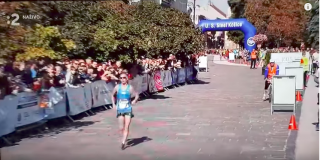
Slovakian Jozef Urban suffered through every male runner’s nightmare at the Košice Peace Marathon last weekend. As Urban was kicking towards the finish line, he experienced a wardrobe malfunction with his running shorts. This resulted in his private parts out on full display, not only to the crowd, but also during the television broadcast of the marathon.
If that is not embarrassing enough, the video of Urban’s pop out has gone viral.
There is some good news to come out of this story though. Urban finished in 10th place with a time of 2:21:51, a 27-second personal best, according to Canadian Running. So he truly let it all hang out in pursuit of his best time.
If you feel inclined to watch the video, it is below. But be warned: it is NSFW!
RELATED: Mystery Runner Won’t Stop Publicly Pooping Around Colorado Town
The post Warning: This Marathoner’s Wardrobe Malfunction Is NSFW appeared first on Competitor.com.
Ryan Hall's Blog
- Ryan Hall's profile
- 21 followers



